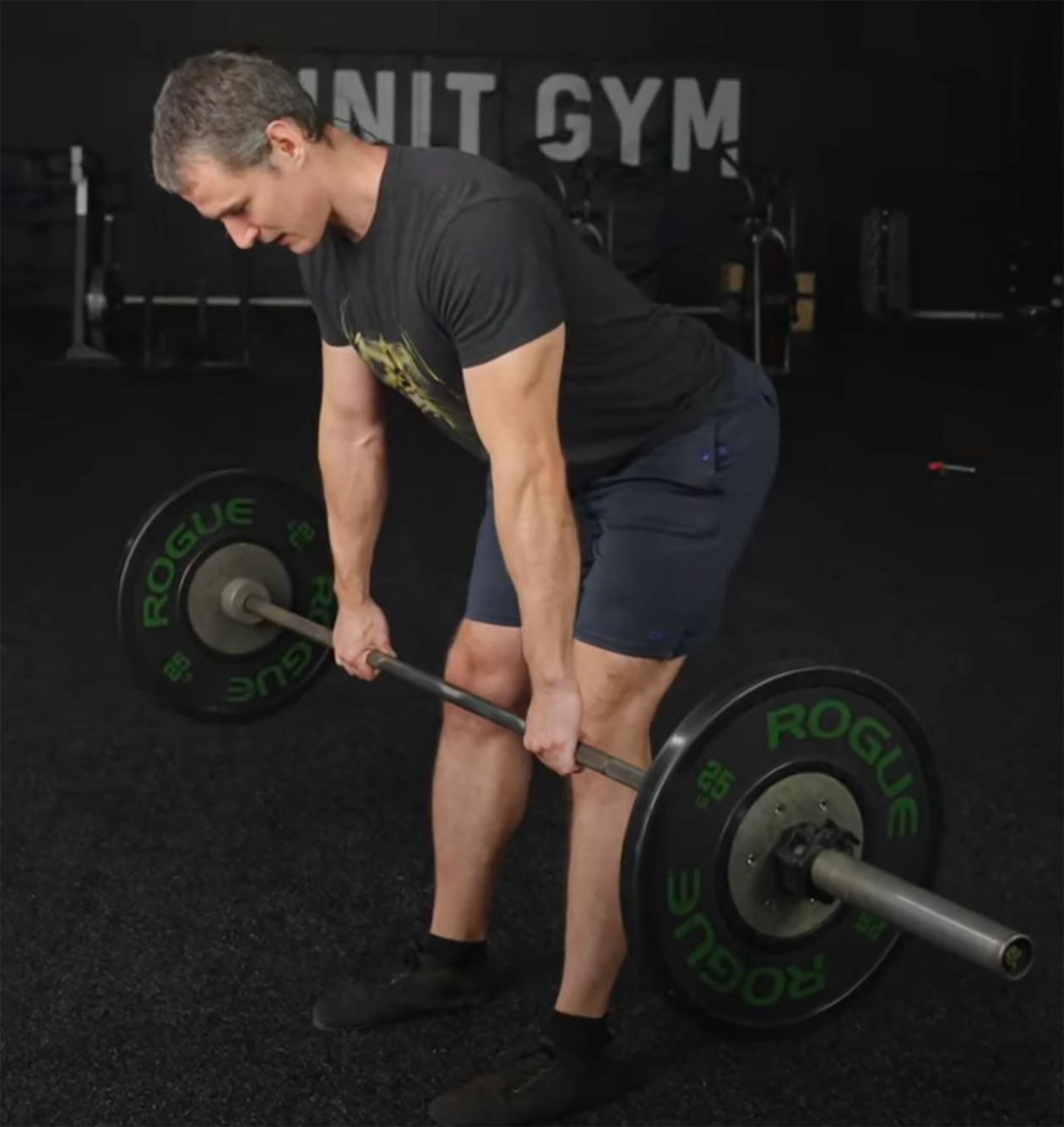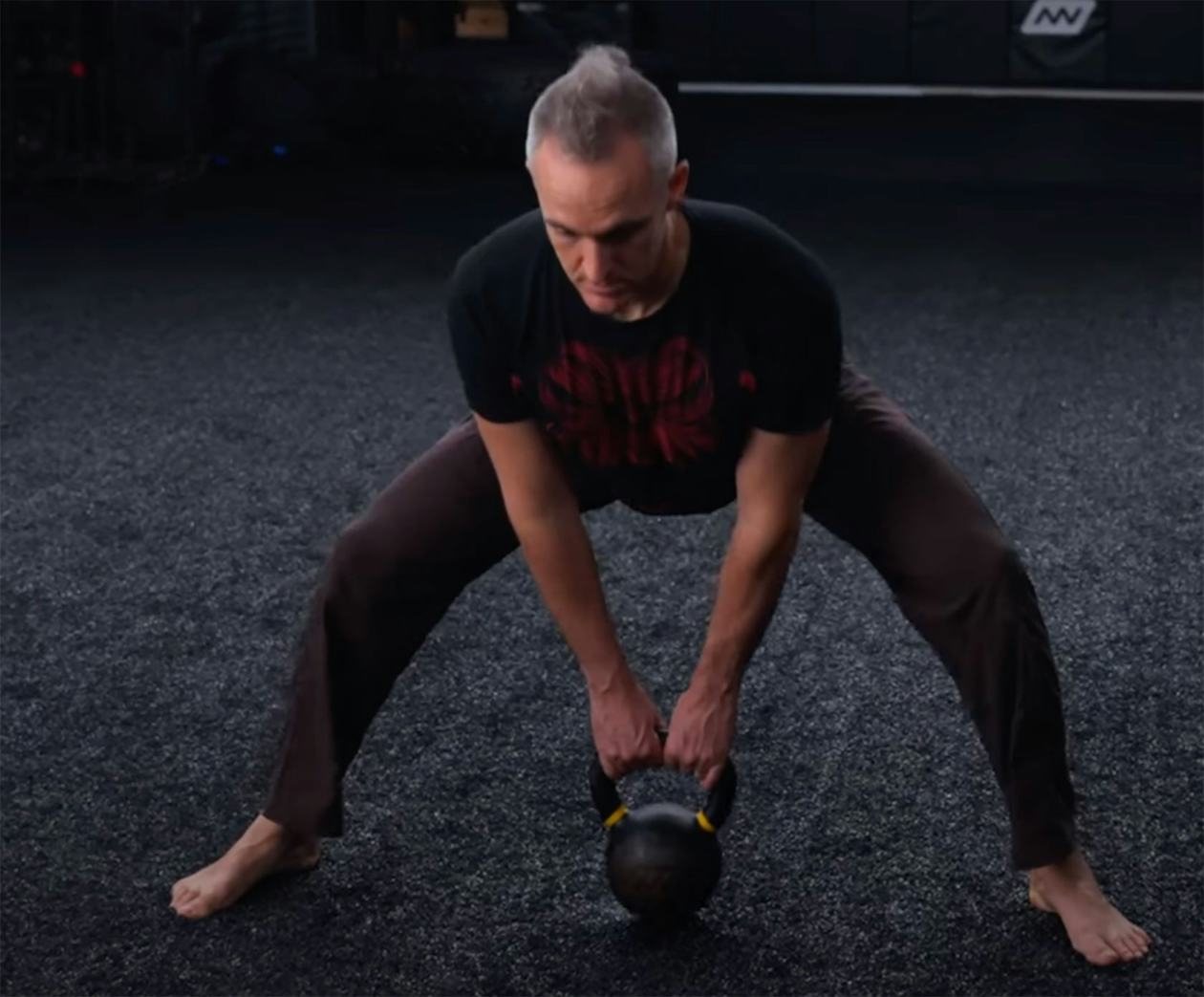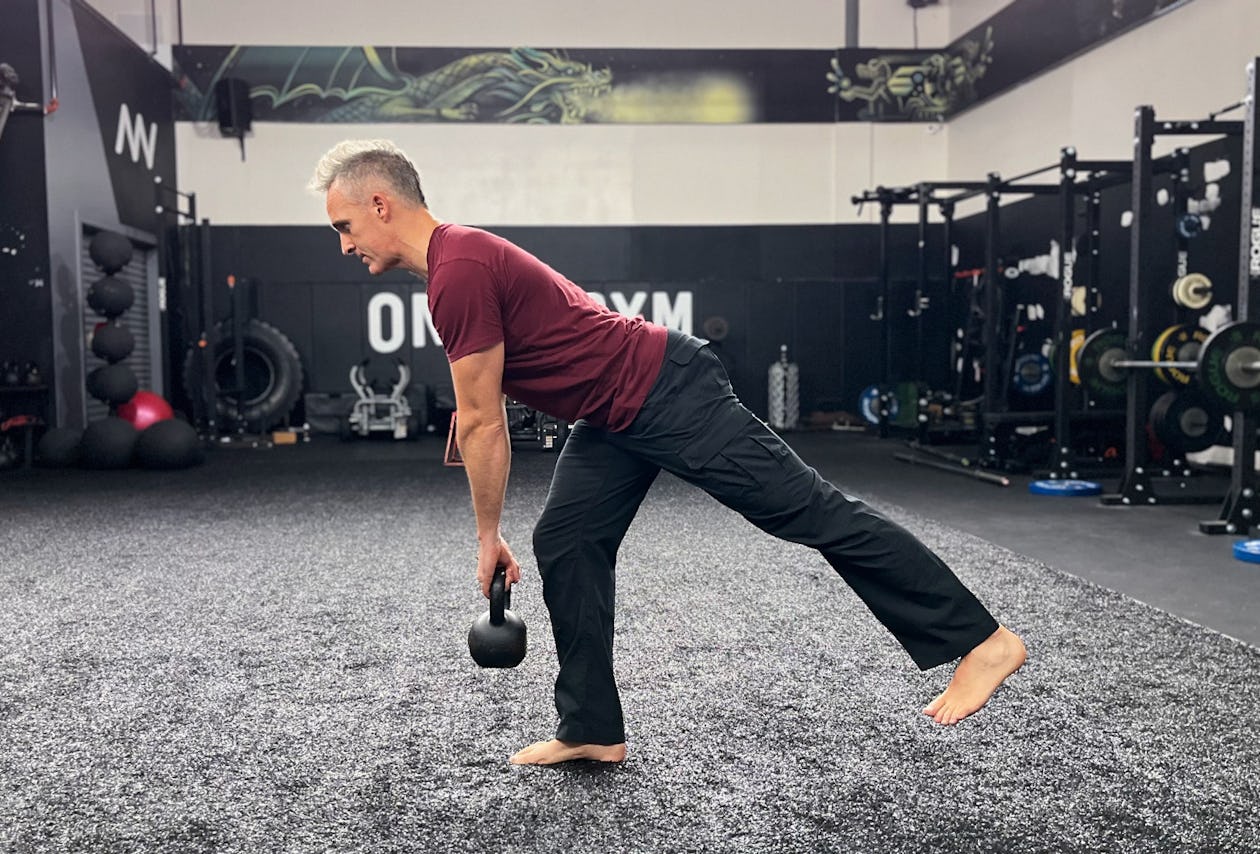The stiff-leg deadlift is similar to a conventional deadlift and a Romanian deadlift, but it’s performed with the goal of better isolating the hamstrings. The form, however, can be tricky, and many people tend to botch it. Master the stiff-leg deadlift and you’ll bring up your hamstrings fast, whether you’re a physique competitor, or an athlete looking to strengthen your posterior muscles for more power and explosiveness.
Key Takeaways
1. The stiff-leg deadlift can be done with a barbell or dumbbells and it targets the hamstrings, with some benefit to the glutes, lower back, and adductors.
2. You should lower the weight slowly and ease into the stretch. Stiff-leg deadlifts put a lot of tension on your hamstrings, so warm up thoroughly and do them late in your workout.
3. Keep your knees slightly bent and try to maintain that angle throughout the lift. Your legs don’t have to be rigidly straight, but they shouldn’t bend so much that you turn the lift into a Romanian deadlift or squat.
4. The difference between the stiff-leg deadlift and RDL is the degree of knee bend. One focuses on the hamstrings and the other on the glutes.
What Is A Stiff-Leg Deadlift and What Are Its Benefits?
(See 00:28 in the video above.)
The stiff-leg deadlift, aka stiff-legged deadlift, or straight-leg deadlift, is a variant of the conventional barbell deadlift done with the intention of targeting the hamstrings as much as possible, with some added benefit to the spinal erectors of the lower back and the adductors (inner thighs). Some people start it from the floor, but we think it’s better in most cases to start standing, with the bar at arm’s length in front of you, and bend your hips back, lowering the bar while keeping your legs nearly straight (or stiff). Then you come back up to standing.
If you do it right, you’ll feel a tremendous stretch in your hamstrings. The stiff-leg deadlift isolates the hamstrings’ hip extension function—that is, your ability to push your hips forward and stand tall—as opposed to their other function, which is bending the knee. If you combine stiff-leg deadlifts with any leg curl variation, you’ve got a complete hamstring workout in just two exercises. (To learn about other deadlifts you can do at home with one or more kettlebells, see our guide to kettlebell deadlifts.)
How To Do The Barbell Stiff-Leg Deadlift
(See 01:16 in the video.)
Step 1. Deadlift the barbell so you’re in a standing position, or, if you have a power rack, start with the bar on the rack at about thigh height. Starting the exercise from standing is safer than pulling straight off the floor with stiff knees, and using a power rack will save you energy getting into position. Grasp the bar with hands shoulder-width apart, and stand with the barbell at arm’s length and your feet hip-width apart.
Step 2. Take a deep breath into your belly and brace your core. Now unlock your hips and tilt your pelvis back—think about pointing your tailbone up into the air.
Step 3. Unlock your knees so there’s a slight bend in them. Think “soft knees.” Now, keeping a long spine from your head to your tailbone, push your hips back as far as you can, as if trying to touch your butt to the wall behind you. As your hips bend, try to keep your knees in the same position.
They’ll want to bend as your hips go further back, and it’s OK to let them move a little bit, but try to keep the same knee angle you started with. If you do it right, you’ll feel a very deep stretch in your hamstrings as your hips move.
Step 4. When your hips are as far back as they can go and your hamstrings are as stretched as you can stand, extend your hips to come back to standing tall.
Tips:
– As your hips go back, focus on keeping your chest up. If someone were standing in front of you, they should be able to see the logo on your shirt. This will help you to keep your lower back flat the whole time. NEVER let it round forward while holding a weight in front of you.
– As you bend your hips, feel your weight shift to your heels. If you feel your weight centered over your feet, or in your toes, you’re not moving your hips properly.
– Take at least two seconds to lower your torso and feel the stretch in your hamstrings. Again, it’s a BIG stretch, so give your body time to ease into it. Bouncing your reps can lead to injury.
– Don’t go any lower than your hips will allow. As soon as you feel they’re pushed all the way back, and your hamstrings are stretched, come back up. Going any lower than that will probably result in your lower back rounding forward, and that will increase injury risk as well as take the emphasis off the hamstrings.
– Keep your lats active, pulling the bar close to your body. It doesn’t have to stay in contact with your legs the whole time as with a conventional deadlift, but the bar should move in a straight line up and down. Relaxing your back would cause the bar to drift in front of you, and that can make you lose your balance.
– Note that if you have particularly tight hamstrings, your range of motion may be small (maybe around knee height), and that’s OK. Don’t stretch beyond where you can control the movement just for the sake of getting more range. As you get stronger and more practiced with the movement, your range of motion will increase.
How To Do The Dumbbell Stiff-Leg Deadlift
(See 03:42 in the video.)
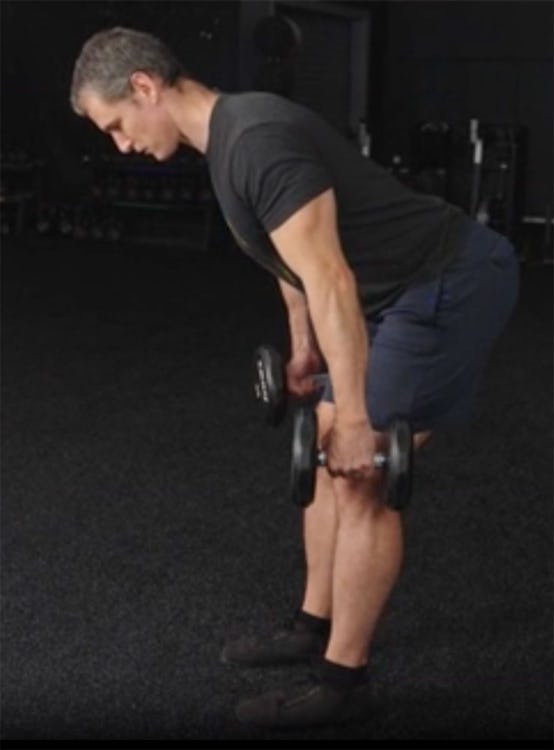
If you don’t have a barbell, or you want to increase your range of motion slightly, you can perform stiff-leg deadlifts with dumbbells or kettlebells. The movement is the same, but the dumbbells will allow you to position the load at your sides rather than in front of your body, and you may find that that allows you to feel the exercise more in your hamstrings and takes pressure off your lower back.
Step 1. Stand with the weights at your sides and your feet hip-width apart. Brace your core.
Step 2. Unlock your hips and your knees, and drive your hips straight back. Keep your knees stiff. When you feel the stretch in your hamstrings, come back up.
Muscles Targeted With The Stiff-Leg Deadlift
(See 04:13 in the video.)
The stiff-leg deadlift primarily works the hamstrings, but it will also train the spinal erectors, as they have to work isometrically to stabilize your lower back. Because you’re performing a hip extension, your glutes will get in on the job too. Finally, your adductors—the muscles that run down your inner thighs—also contribute to the movement.
Pro Tips: How To Avoid Common Mistakes When Deadlifting
(See 04:30 in the video.)
Mistake #1: Rounding your lower back
You’ll see some people in the gym and online doing stiff-leg deadlifts purely as a back exercise—sometimes intentionally, and sometimes not. They’ll bend at the waist instead of the hips, completely rounding their lower back. Or, in an effort to increase the range of motion, they’ll round their back toward the bottom of each rep. In either case, it’s usually a bad idea, as it can lead to a back injury.
The stiff-leg deadlift is meant to be done almost entirely by the hips. Once you can’t move them back anymore, extend your hips to come back up. Your body should form a straight line from your head down to your tailbone throughout the whole movement.
Mistake #2: Locking The Knees
Your goal should be to keep your knees from bending, but that doesn’t mean lock them out entirely. Locking your knees can cause too much tension in your hamstrings and lead to injury. Think “soft knees,” and let them bend just enough so that you get the best range of motion out of your hamstrings without losing tension in them.
Mistake #3: Bending The Knees Too Much
If you bend your knees the entire time you bend your hips, you’re going to turn the stiff-leg deadlift into a Romanian deadlift, conventional deadlift, or a squat. If at any time you feel your quads tensing up, you know you’ve bent your knees too much. Think about it like this, if your knee angle is totally straight, your knees would be 180 degrees, and if they were bent halfway, they’d be 90 degrees, so aim for roughly 160 degrees of knee bend.
Stiff Leg Deadlift Vs. Conventional Deadlift: Key Differences
(See 06:44 in the video.)
A conventional deadlift starts with the bar on the floor, and it allows you to bend your knees more so that your quads and glutes can contribute more to the movement. This makes the conventional deadlift a great overall strength exercise for the lower body.
In the stiff-leg deadlift, the goal is to take the quads and glutes out of the equation as much as possible to better isolate the hamstrings. To do this, you have to keep the knees nearly straight and focus on bending only at the hips.
For these reasons, the conventional deadlift is used more by powerlifters and weightlifters looking to strengthen the lower body as much as possible, while the stiff-leg deadlift is more popular among bodybuilders and other physique or figure athletes who are trying to develop each individual muscle group to its best potential.
Stiff-Leg Deadlift Vs. Romanian Deadlift
(See 07:25 in the video.)
The stiff-leg deadlift looks similar to another deadlift variant that starts from the standing position: the Romanian deadlift. Some coaches argue the two movements are really the same, but we see some subtle differences. In a Romanian deadlift, your knees are free to bend so that you can push your hips back as far as possible. That shifts the emphasis from the hamstrings to the glutes, and it allows you to use heavier loads. You’ll see powerlifters and weightlifters using Romanian deadlifts often to strengthen their glutes for bigger squats, deadlifts, and cleans, while the stiff-leg deadlift is usually the better option for bodybuilders and other physique/figure competitors chasing hamstring gains.
Look at the two pictures below, which show the bottom position of each lift, and the difference should be pretty clear. The first one is the stiff-leg deadlift, and the second is the RDL.

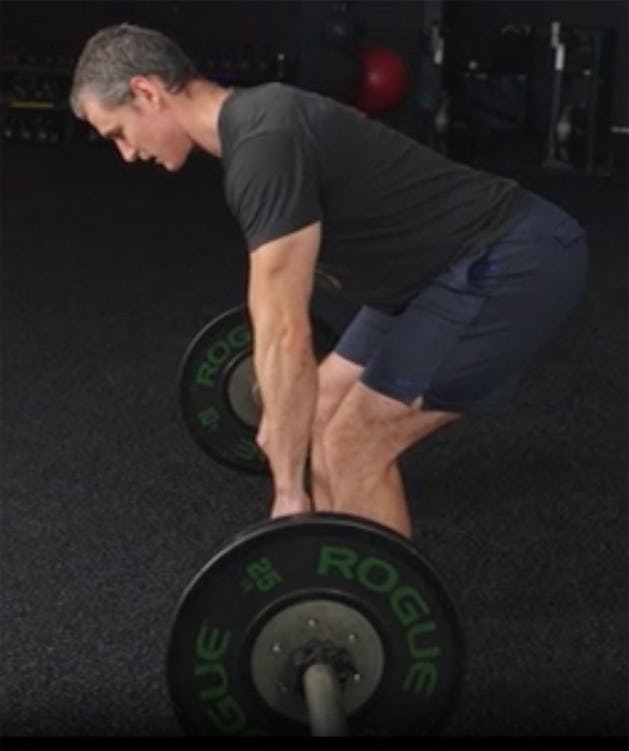
Straight-Leg Deadlift Variations
You can train the basic stiff-leg deadlift with a little more isolation and range of motion if you do it one leg at a time. Check out this article for a whole guide to single-leg deadlifting.
Straight-Leg Deadlift Alternatives
If you want another option that’s a little easier on both the hamstrings and the lower back than the single-leg deadlift, check out our guide to the B-stance Romanian deadlift.
How To Warm Up Before Stiff-Leg Deadlifts
(See 09:50 in the video.)
The stiff-leg deadlift is NOT an exercise that you want to jump into cold. With all the stretch it puts on the hamstrings, you need to warm up thoroughly beforehand. Here are two moves that will warm up your hamstrings and open your hips before you get into stiff-leg deadlifts.
Bodyweight Hip Hinge
Step 1. Stand with feet parallel and bend your knees slightly.
Step 2. Now drive your hips back as far as you can while keeping a long spine from your head to your tailbone. When you feel a stretch in your hamstrings, or you can’t push your hips back any further without losing your spine position, come back up to standing. REPS?
Hip Flexor Stretch
Step 1. Kneel on the floor with one knee. Both hips and knees should be bent 90 degrees. Now tuck your tailbone under so your pelvis is level with the floor. Brace your core.
Step 2. Shift your weight forward, moving your front knee past your toe, until you feel a stretch in the front of the hip on the back leg. Keep your hips and shoulders facing forward. Your front foot must also stay flat on the floor. Hold for 30 seconds. REP?
It’s best to do stiff-leg deadlifts at the end of your leg days, preferably after you’ve done leg curls or another hamstring and/or glute exercise. Because the exercise puts your hamstrings under such an intense stretch, you don’t want to rush into them when you’re cold and not comfortable doing a full range of motion.
Who Should Do Stiff-Leg Deadlifts?
(See 11:39 in the video.)
If you’re someone who wants to slap some more meat on their hamstrings, the stiff-leg deadlift should be a cornerstone of your leg workouts. Also, if you’re a sprinter, other kind of track athlete, or anyone else who runs a lot in their sport, the stiff-leg deadlift will help you build strong hamstrings, which are key for fast, explosive running. Finally, if you compete in strength sports, like weightlifting or powerlifting, the stiff-leg deadlift will help strengthen the muscles you need to pick up big weights.
